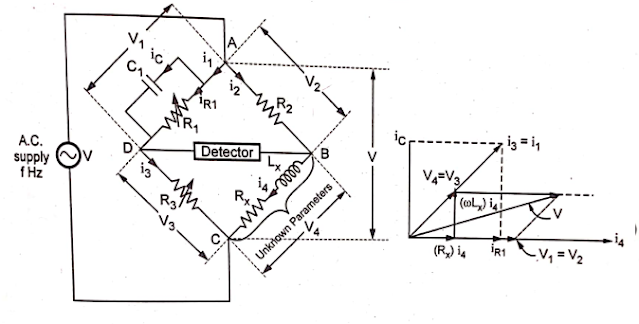Maxwell's Bridge
Maxwell's bridge can be used to measure inductance by comparison either with variable standard self-inductance or with a standard variable capacitance. These measurements can be done by using Maxwell's Bridge in two different forms.
Maxwell's Inductance Bridge
Using this bridge, We can measure inductance by comparing it with a Standard variable self-inductance arranged in a bridge circuit as shown in Fig. (a).
Consider Maxwell's inductance bridge as shown in Fig (a). Two branches consist of non-inductive resistances R1 and R2. One of the arms consists of Variable inductance with series resistance r. The remaining arm consists of unknown inductance Lx.
Maxwell's Inductance Capacitance Bridge
Using this bridge, we can measure inductance by comparing it with a variable standard capacitor. The bridge circuit diagram is shown in Fig.One of the ratio arms consists of resistance and capacitance in parallel. Hence it is simple to write the bridge equations in the admittance form.
The advantages of using standard known capacitors for measurement are :
1) The capacitors are less expensive than stable and accurate standard inductors
2) The capacitors are almost lossless.
3) External fields have less effect on a capacitor. The standard inductor requires shielding in order to eliminate the effect of stray magnetic fields.
4) The standard inductor will not present its rated value of inductance flow through it is precisely adjusted.
5) The capacitors are smaller in size.
This bridge is also called the Maxwell Wien bridge.
Advantages of Maxwell Bridge:
1) The balance equation is independent of losses associated with inductances.
2) The balance equation is independent of the frequency of measurement.
3) The scale of the resistance can be calibrated to read the inductance directly.
4) The scale of R1 can be calibrated to read the Q value directly.
5) When the bridge is balanced, the only component in series with the coil under test is resistance R2. If R2 is selected such that it can carry high current, then heavy current-carrying capacity coils can be tested using this bridge.
Limitations of Maxwell Bridge
1) It cannot be used for the measurement of high Q values. Its use is limited to the measurement of low Q values from 1 to 10.
2) There is an interaction between the resistance and reactance balances. Getting the balance adjustment is a little difficult.
3) It is unsuited for the coils with low Q values, less than one, because of the balance convergence problem.
4) The bridge balance equations are independent of frequency. But practically, the properties of the coil under test vary with frequency which can cause errors.
Commercial Maxwell bridge measures the inductance from 1 - 1000 H, wi ± 2 % error.




Comments
Post a Comment